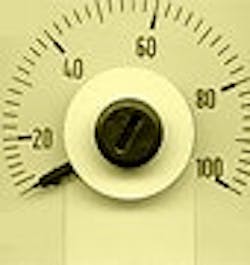Panel Meters Take on New Jobs
By Jim Montague, Executive Editor
What have panel meters done for you lately? Well, as their power and functions increase and as machine operators assume more responsibility for running them, the question may soon be, “Is there anything panel meters can’t do?” As a result, more users want to know exactly what the devices are capable of and whether they might do some of the jobs of a small PLC/HMI combination.
Panel meters are increasing their available output capabilities, says Vince Leonardi, group technical leader/applications engineer for Omega Engineering. “Our DP41B series is available with four open collectors and four relay outputs, plus Ethernet connectivity,” he says. “While not capable of doing mathematical computations, the meter is flexible for more event/alarm situations and can be viewed over a network.”
As always, cost remains an issue. “By the time you add smart functionality and communication boards, panel meters start to approach the cost of micro and pico PLCs and small HMIs,” says David Kaley, product marketing manager at Omron Electronics. “Even if only one or two critical parameters are monitored, HMIs can combine external switches and a more informative display in one package. This brings down the installed cost and increases system reliability by involving fewer separate components.”
Kaley says Omron’s panel meters can change display colors to accentuate a status change, “but this function isn’t widely embraced and is seldom used,” he adds. From a machine lifecycle view, smaller PLCs allow machine designers and programmers to worry about one programming structure instead of multiple structures and software for various panel devices, adds Kaley.
“When we look at the market and users’ preferences, we see two contradictory trends,” says Avner Barak, technical business development manager at Unitronics. “On one hand, customers like the ability to separate the system into object-oriented components, allowing each part to do its own task. On the other hand, combo products are becoming more popular, providing a less expensive solution to the entire system’s requirements.” PLCs are acquiring meter-like capabilities and can replace them in certain systems, adds Barak.
It’s unlikely that panel meters will replace PLCs and HMIs anytime soon, but meters can now be used not only to display information but also as a convenient means for local control and as a component in redundant backup systems. Leonardi believes the trend in panel meters isn’t so much moving toward PLC capability, but blending in controller functions to become more universal. “In the past, you might have had to purchase three devices—one to measure a process, another to control the process and a third as a safety limit device. Now users can program one unit to be a panel meter with alarms, a PID controller with auto-tune or a safety-limit controller.”
So, how much real control can we get from a panel meter today? “On/off control, PID and one ramp-and-soak program are all possible with our iSeries,” says Leonardi. Auto-tuning, he adds, is already standard.
“Panel meters can be used for simple machine control, allowing maintenance staff to make real-time adjustments in response to changing production conditions reflected in panel meter readings,” says Jeff Thornton, product manager at Red Lion Controls. “This ensures that production remains as efficient as possible and eliminates the time and costs spent on enlisting a programming engineer’s assistance to provide PLC support.”
Panel meters also can be used in conjunction with PLCs as part of a redundant system to help ensure the safety of production equipment and operators. For example, says Thornton, if a PLC used to control conveyor speed in an assembly application fails, a panel meter can be programmed to deliver a local readout of conveyor speed and cut off power to the conveyor if it exceeds the maximum speed allowed.
There will be a few niche applications where a smart panel meter makes sense, adds Kaley. “But, we think those spaces are too few to justify further development of panel meters with integrated logic.” Too true for now. but maybe not for long.

